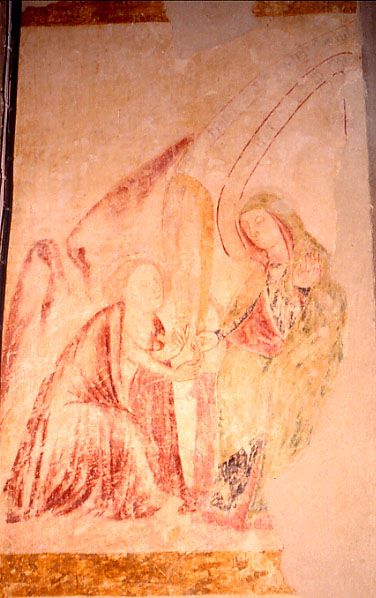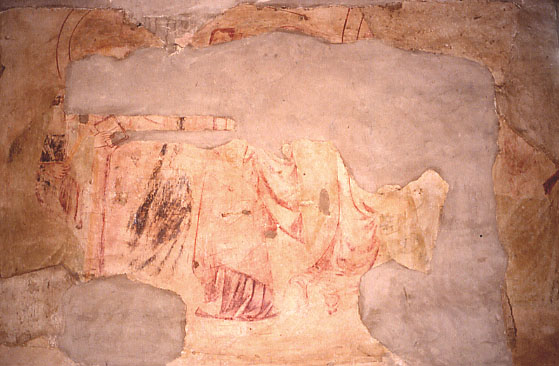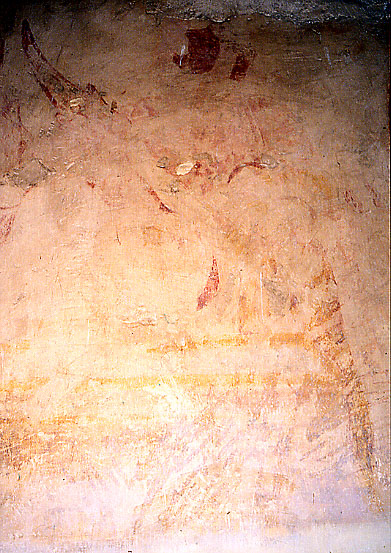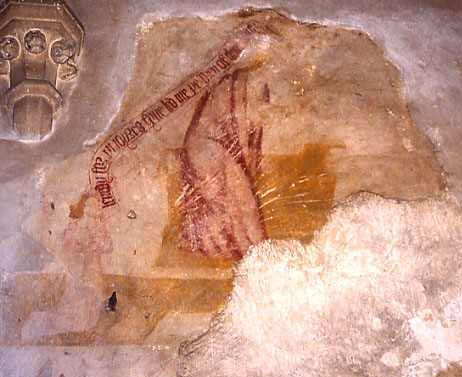Broughton, Oxfordshire (†Oxford). C.14
The Death of the Virgin

This important series of paintings depicting the Death, Burial and Assumption of the Virgin is on the north wall of the chancel at Broughton. Although badly damaged in parts, it is one of the fullest examples of the subject that we have.
The clearest scene is one of the rarest of all, the Annunciation, not of Christ’s impending birth, but of the Virgin’s own approaching death. The story, based on various apocryphal sources, relates how, after her Son’s death and resurrection, Mary longed to be reunited with him, and her prayers that she might soon die and go to heaven were answered in due course when an angel, usually identified as Gabriel, came to her, presented her with a palm branch, and announced that she would receive her wish in three days’ time.
This is the scene shown at the right, with Gabriel kneeling and the seated Mary taking from him the upright yellow palm branch. The speech-scrolls of both figures are unfortunately unreadable now.

The next scene is substantially damaged, but it is believed to be the next incident in the story, the gathering from many far-flung parts of the world of the Apostles, who came to be present at Mary’s death and Burial. At least four or five figures are discernible or implied in the photograph at the left. The Apostle at the extreme left holds a book, and parts of speech-scrolls are again visible.
Only a fragment of the next scene remains, but it shows (below, left) a corner of a tomb, with a figure bending over it, and this is probably the Burial of the Virgin, a subject freely embroidered by apocryphal sources to include stories such as the attempt by unbelieving Jews to overturn the bier. That particular detail was painted, and remains at Pickering in North Yorkshire, but if it was included at Broughton, it has disappeared now. There is a trace of one figure, probably another of the Apostles, with a speech-scroll at the top of the scene.


The next scene, again badly damaged, is probably the return of the Apostles to the Virgin’s tomb to find the Virgin gone and the tomb full of roses. There is no sign of these in the scene now (photograph, right), but most of the tomb, the haloes of several Apostles, and the wing of an angel (who may be gesturing above to indicate Mary’s bodily Assumption) at the far left, can all be made out. Given that this is the only example of the tomb full of roses story that I know of in the English church, I have included the faded and indistinct details at the right below.
Much clearer is the Assumption itself, with the Virgin shown ascending to Heaven within an almond-shaped mandorla (below, left). Here again, fanciful details enter the story. Thomas, the Apostle who asked to see Christ’s wounds, was absent (in India, according to some stories), and arrived too late to see the rose-filled but otherwise empty tomb. True to his reputation for scepticism, he was dubious, and received confirmation of her Assumption from the Virgin when she handed down her girdle from Heaven. The girdle shows as a faint yellowish band, below the Virgin’s elbow and curving down to the right outside and below the mandorla in the photograph. Thomas is no more than a faint ghostly presence at the lower right of the scene, again beyond and below the mandorla, but his right hand reaching out to grasp the girdle is just visible.


The final scene in the series suggests that a priest may have been the donor of this series of paintings, which would also explain why they are in the chancel as opposed to the nave. The Coronation of the Virgin is the last painting in the series, furthest east on the chancel wall and thus very near the high altar. The Virgin is evidently being crowned by her Son, although the right-hand side of the golden-painted throne, where Christ would have been seated, is very obscure and only the figure of the Virgin can be seen on it now. Below at the left, however, a tonsured priest, the likely donor, kneels, and a scroll above him, which has been repainted at some time¹, reads ‘Leudedy [Lady] for thi Joyzes fyve led me the wey of clene lyve’. Not only is this an early use of English, as opposed to Latin, in painted inscriptions, but it is also a rare, indeed probably unique, reference in English wall painting to the Five Joys of Our Lady (Annunciation, Nativity, Resurrection, Ascension and Assumption), only the last of which is actually painted here.
There are several other paintings at Broughton, including a ‘detached’ Crucifixion.
¹Tristram III, p.145; – ET Long, Medieval Wall Painting in Oxfordshire Churches, Oxfordshireiesia, vol. XXXVII, 1972, p.93